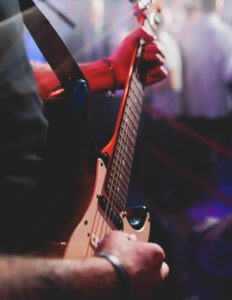From Strategies to Singles
Published on October 10, 2023, 4:05 p.m.
by Ali Burleson.
When working in the music entertainment business, the saying “It doesn’t take a village, it takes an army,” is no joke. Preparing to sell out the Mercedes Benz Stadium, acquiring beneficial brand partnerships and curating media advertisements to increase consumer engagement are all things that fall into the job description of your favorite artists’ promotional team.
With the help of a record label, public relations professionals and dedicated marketing departments, artists who have signed deals receive extensive assistance to pave their path to success in the music industry.

Navigating the digital and traditional media landscape
In the digital age, media serves a dual purpose: Not only does it facilitate promotion, but it is also used in analyzing research and pinpointing the ideal target audience. “From a marketing standpoint, our goal is to get an event, festival or concert in front of the people that enjoy it,” Hollie Evans, digital marketing coordinator at Premier Productions Inc., explained. “That is something that, strategically, marketing has gotten to dig around and find trends, statistical-buying patterns and geographical differences.”
Whether the practitioner is promoting an artist, concert or festival, one thing remains clear: Social media continues to assert its dominance as an essential platform.
Traditional media, like radio advertisements and billboards, hasn’t lost its connections with consumers yet, according to Evans. Traditional media serves as a complementary tool to enhance the promotion already taking place on social media.
“I think [consumers] will get that instant appeal from social media, but consumers can’t always purchase instantly,” Evans said. “So, after a radio advertisement, it may remind them that they want to buy tickets. We want to hit as many touch points as possible.”
Artists are always trying to find innovative ways to connect with their fan bases. That is why it’s important to have all department heads collaborating to gain positive exposure.
Traci Hite, the regional promotions director at Stone Country Records, collaborates with the marketing team, social media department and artist management to develop a coordinated “roll-out plan” for generating creative ideas in promoting the release of artists’ new music across all listening platforms.
Signed artists of the label go on radio tours across every region within the scope of the United States to help form a relationship with radio stations and build visibility with target audiences. “Our main goal on a radio tour is to introduce artists and their music

to radio-listening audiences across the country,” Hite explained when asked about the reasoning behind radio promotion.
Bobby Bones is no stranger to the radio world and captures the attention of country fans with his radio talk show, “The Bobby Bones Show,” by having many different artists as guest interviewees.
When talk show hosts like Bones repeatedly share these interviews, both on radio ads and by tagging artists on social media, it
“enhances promotion” and brings “greater exposure” to artists and their music, according to Hite.
How mutually beneficial partners set the stage for success
Public relations can be described as the practice of creating mutually beneficial relationships between an organization and its publics. Likewise, brand partnerships have become a mutually beneficial avenue in the entertainment sector.
For artists, these collaborations extend far beyond the confines of their creative endeavors, offering a gateway to expand their influence, engage with a broader audience and secure more revenue.
Taylor Swift, for example, is a savvy businesswoman; therefore, her partnerships with organizations like Coca-Cola and Apple align with her image and expand her reach.
At the same time, a prominent organization such as the Country Music Association (CMA) reinforces its messages and objectives by partnering with brands that hold the values it does.
CMA Fest, the longest-running, largest, country music festival in the world, attracts renowned artists who volunteer to perform. Notably, half of the proceeds from brand partnerships are directly reinvested into music education.
According to Ansley Carlson, CMA’s brand partnerships coordinator, CMA Fest is “a staple of Nashville.”
“We want to align CMA Fest with brands that just make sense of the space. It’s summertime, [with people] listening to country music in the outdoor heat for four days, so we want to make sure there is a natural fit,” Carlson said. “We want to make sure all our brand partners want to have face-to-face interaction with our fan base, because we want to create a fun experience for all of our attendees.”
The synergy forged through these collaborations serves as a driving force for innovation and creativity, creating deeper connections between consumers and artists. This evolving trend of brand partnerships harmonizes seamlessly with market dynamics.
The secret is out
For practitioners everywhere, it’s important to meet the consumer where they are and fulfill their needs.
“We have to lean into where the fan is and what the fan wants,” Evans said. “A quick clip and instant gratification mindset is how we engage these buyers and ensure they are aware that we offer what they want in 15-20 seconds.”
In a world that never slows down, consumers seek immediate satisfaction and access to their favorite artists.
To build anticipation, artists often pre-release singles and teasers to provide instant access to new music, building excitement and consumer engagement for album releases. Streaming services like Spotify and Apple Music have capitalized off the instant gratification mindset by offering on-demand access to all music, instantly fulfilling consumers’ desire for media consumption.
However, when it comes to selling out arenas and building a fan base, PR practitioners should leverage the concept of instant

gratification by strategically pinpointing where the interested consumers are and bringing an artist to them.
Quick, accessible and engaging content is key to fostering fan loyalty and providing fans with immediate experiences that resonate with their desire for instant access and engagement.
Why it should matter
Within the music entertainment business, public relations and marketing strategies play a pivotal role in an artist’s image and ensuring sold-out venues. Media relations, brand partnerships and adhering to the needs of consumers all work together intricately to provide success. The intertwined discipline of the two types of strategies sets the stage for artists to shine brightly in the spotlight of the entertainment industry.




